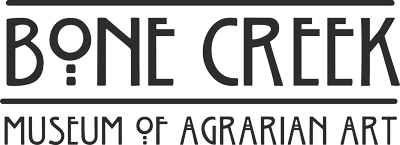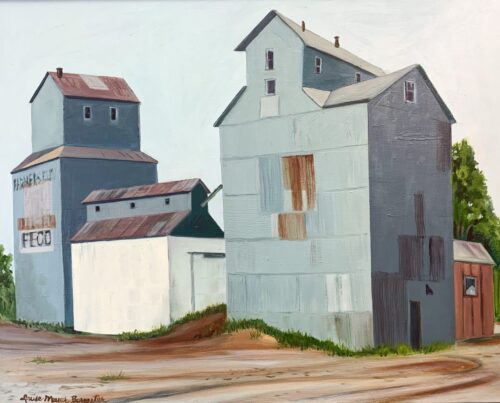Nov. 21, 2020 – Feb. 28, 2021
Paintings of grain elevators in Eastern Nebraska will grace the walls of the Bone Creek Museum of Agrarian Art Nov. 21, 2020 through Feb. 28, 2021. The museum in David City is free of charge and open to the public. Face masks are currently required.
Featured artist Louise Bereuter now splits her time between Lincoln, Nebr. and California. These paintings were made when she and her husband, a former state politician, were living north of Cedar Bluffs. “It was easy finding inspiration for landscapes, many of which were areas seen while roaming the rural back roads of Nebraska as well as views surrounding our Nebraska home along the Platte River,” she said.
Variations on a theme are common for many artists. “Consider a painting as an experiment or tool for exploration. Through repetition, representational artists hone their skills by looking at color and shape more critically and finding successful ways to depict what they see,” said curator Amanda Mobley Guenther. Bereuter was inspired by the cultural symbolism of barns and grain elevators but also by the forms themselves, compositions of geometric shapes: squares, triangles, rectangles and cylinders.
“My father, an artist, and a graduate of the Chicago Art Institute, encouraged my artistic interests and endeavors at an early age,” said Bereuter. She always knew she wanted to be an artist and to teach art. And she did just that, teaching art for twenty years in Nebraska and Virginia.
While a student at the Boston School of the Museum of Fine Arts in 1960, she worked at the Boston Museum of Fine Arts, where she met one of her artistic heroes, famed urban realist painter Edward Hopper. “My work has been compared to his,” said Louise, because of the style of quiet and stark depiction of landscape, most often including buildings. An accomplishment all realist artists find pleasure in is to turn the ordinary into the ‘extra’ordinary. Bereuter’s nostalgic reminders of rural life can help their viewers to see and consider their own history.


